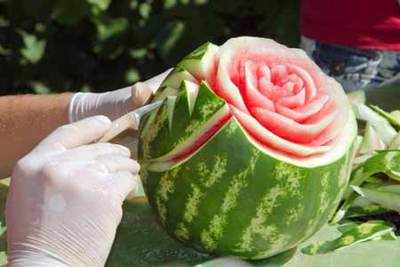Trending
This story is from May 24, 2013
How about a fruit carving for your dinner party?
A watermelon can turn into a basket, while a pumpkin turns into an owl and a radish makes for roses.

A watermelon can turn into a basket, while a pumpkin turns into an owl and a radish makes for roses. It’s not magic, say hello to the art of fruit and vegetable carving — a culinary table decoration that looks as good as it tastes!
A little history to it
The story goes that this began roughly 700 years ago in Sukothai, (now north of central Thailand). During the Loi Krathong festival, these carvings or sculptures were placed on traditional crowns and then placed on water.The festival is celebrated today too.
Fruit that looks as good as it tastes
Does one need to freeze the fruit before hand? “No, not at all, the arrangement can be chilled after the carving to make it last longer. And certain fruits need to be raw — like papaya and watermelon.” Any fruits that are tough to carve and avoidable? “Pineapple, due to its skin. Also grapes are small and can be used as buds while strawberries are too mushy."
Vegetables can be carved too
Expert Nirali Mehta who teaches people the art states that vegetable carving is also easy — all one needs is the some creativity and a basic knowledge of the different fruits and vegetables. “I have used vegetable arrangements as centerpieces in small house parties and they have turned out great. There's a lot one can do — I have made roses from beetroot, leaves from cucumber and radish and different flowers from onion — which is the simplest vegetable to carve.”
She also says Indian vegetables lend themselves to carving very well. “Kantola or karela (bitter gourd), for instance. I also made an arrangement of sweet potato and radish birds. Teacups from cucumber can be used as decorative bowls to serve dips and chutneys with salads and starters.”
What is the shelf life of these? “The shelf life is usually as much as that of a normal fruit and vegetable since your not doing anything to preserve it, usually about two-and-a-half to three hours. But if kept in cold climate or an air-conditioned room it can look fresh longer. Also, it is important to use fresh vegetables and not the ones from a cold storage, in order to get the best results,” she advises.
A little history to it
The story goes that this began roughly 700 years ago in Sukothai, (now north of central Thailand). During the Loi Krathong festival, these carvings or sculptures were placed on traditional crowns and then placed on water.The festival is celebrated today too.
Fruit that looks as good as it tastes
Want an elaborately done décor to go with the dinner you’re organising? Mumbai-based fruit carver Neetu Saneja has a few fun tips. She’s done entire ‘bouquets’ made with fruits and, in fact, whatever catches her eye! “That’s the best part of this kind of carving,” she says. “The fruit has such vivid colours and the different shapes can be used to make different things. Pumpkin and figs flowers, faces from watermelon…anyone can try their hand at shapes, all you need is a good sharp knife.”
Does one need to freeze the fruit before hand? “No, not at all, the arrangement can be chilled after the carving to make it last longer. And certain fruits need to be raw — like papaya and watermelon.” Any fruits that are tough to carve and avoidable? “Pineapple, due to its skin. Also grapes are small and can be used as buds while strawberries are too mushy."
Vegetables can be carved too
Expert Nirali Mehta who teaches people the art states that vegetable carving is also easy — all one needs is the some creativity and a basic knowledge of the different fruits and vegetables. “I have used vegetable arrangements as centerpieces in small house parties and they have turned out great. There's a lot one can do — I have made roses from beetroot, leaves from cucumber and radish and different flowers from onion — which is the simplest vegetable to carve.”
She also says Indian vegetables lend themselves to carving very well. “Kantola or karela (bitter gourd), for instance. I also made an arrangement of sweet potato and radish birds. Teacups from cucumber can be used as decorative bowls to serve dips and chutneys with salads and starters.”
What is the shelf life of these? “The shelf life is usually as much as that of a normal fruit and vegetable since your not doing anything to preserve it, usually about two-and-a-half to three hours. But if kept in cold climate or an air-conditioned room it can look fresh longer. Also, it is important to use fresh vegetables and not the ones from a cold storage, in order to get the best results,” she advises.
End of Article
FOLLOW US ON SOCIAL MEDIA









